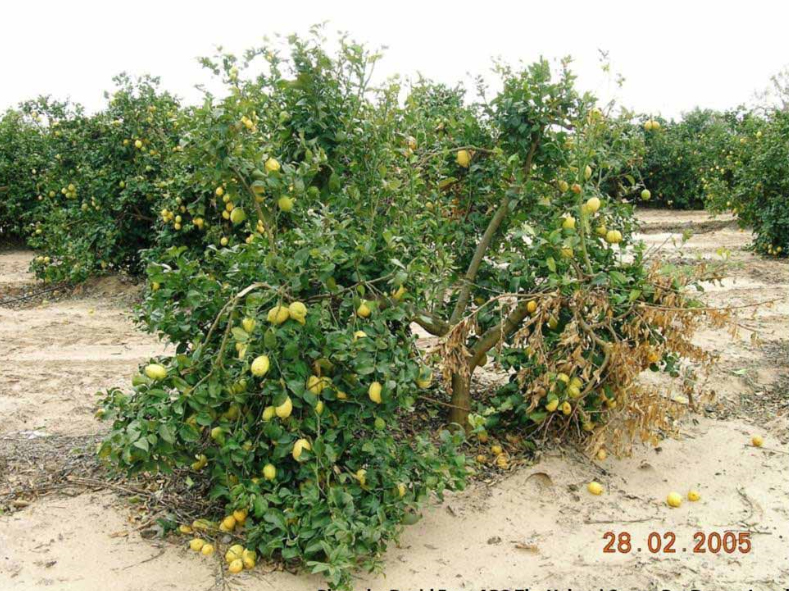 Mal secco
Mal secco
 Scientific Name
Scientific Name
[Fungus] Phoma tracheiphila (Petri) Kant. & Gik. (syn. Deuterophoma tracheiphila Petri)
Other common names
“mal fulminante” a rapid fatal form that is apparently caused by root or stem infection
“mal nero” referring to internal wood browning
Disease cycle
Conidia are produced in pycnidia found on withered twigs and from hyphae growing on exposed wood or debris, including branches, leaves, and fruits. Most probably the pathogen can also be transmitted to other trees through contaminated pruning tools. Twigs and leaves lying on the soil may be a source of inoculum for infection through wounded roots. Leaves infected by the fungus fall to the ground during autumn and spring, and the fungus within the leaf tissue are able to sporulate at temperatures ranging from 10 to 25°C (55 to 77°F).
Under natural conditions, the inoculum can be dispersed by wind and rain; P. tracheiphila penetrates the host through wounds via both conidia and mycelium. Infection usually occurs during the winter. Although the optimum temperature for pathogen growth is about 25°C (77°F), optimum temperature for symptom expression and xylem colonization is 20 to 22°C (68 to 72°F). Infection occurs between 14 and 28°C (57 and 82°F), whereas at temperatures above 28°C (82°F), fungal growth ceases and symptoms are not expressed. A unique characteristic of this fungus is its ability to produce a- sexual spores called phialoconidia. These are spores formed on the mycelium in the plant xylem released into the transpiration flow. When a spore reaches a location where it can germinate it forms new hyphae causing disease.
Symptoms
Typical symptoms include veinal chlorosis, leaf wilt; red coloration of the xylem and dieback of twigs and branches; in many cases dieback is sectorial. The pathogen proceeds slowly downward from the infected young shoots to the branches and main limbs; when the trunk and roots become infected, the tree dies. When the fungus infects the base of a trunk or the roots, a phenomenon can occur known as – mal fulminante. In these cases, the tree usually dies quickly.
Host range
The principal host of mal secco is lemon. The disease is highly destructive on lemon, and citron (C. medica L.), lime (C. latifolia Tan.), and bergamot (C. bergamia Risso) also have been reported to be very susceptible to natural infections. Different degrees of resistance are shown by other species and hybrids. Sweet orange (C. sinensis (L.) Osbeck), grapefruit (C. paradisi Macf.), clementine mandarin (C. clementina Hort.), tangerine (C. reticulate Blanco), and mandarin (C. deliciosa Tenore) are affected sporadically by the disease and are considered tolerant. Among rootstocks, sour orange (C. aurantium L.), the most widespread lemon rootstock in Italy, Greece, and Turkey, rough lemon (C. jambiri Lush.), Volkamer lemon (C. volkameriana Ten. & Pasq.), and alemow (C. macrophilla Wester) are very susceptible. Reports on the degree of susceptibility of citrus species to mal secco are sometimes contradictory, especially for rootstocks. Sour orange, for example, is considered to be very susceptible in Italy, but only moderately affected in Israel. It can be stated that almost all citrus species are susceptible to P. tracheiphila when artificially inoculated by wounding.
Distribution
Mal secco is present in all the citrus producing countries in the Mediterranean and Black Sea areas with the exception of Spain, Portugal, Morocco, and some areas of the Arabian Peninsula. The disease is not known to occur in the citrus-growing countries of the Americas or Oceania, even though there is no obvious climatic or cultural factor limiting the establishment of mal secco disease in non infested areas.
Easily confused with
Citrus blast (Pseudomonas syringae pv. syringae)
We currently serve - Mesa – Gilbert - Tempe - Chandler - Queen Creek - Scottsdale – Paradise Valley - East Phoenix Arizona.
